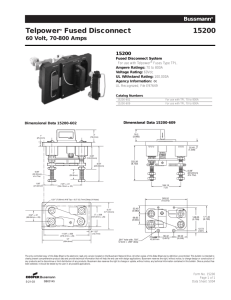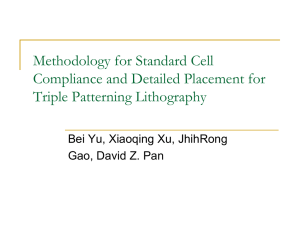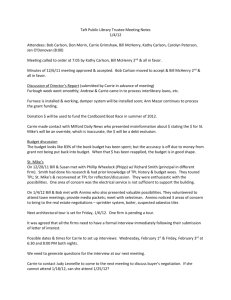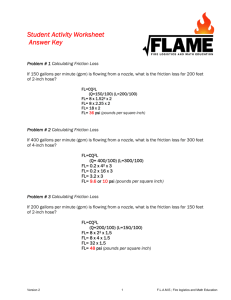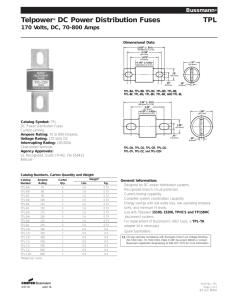Concept System Analysis of the ThirdPlaceLearning Theory To cite this version:
advertisement
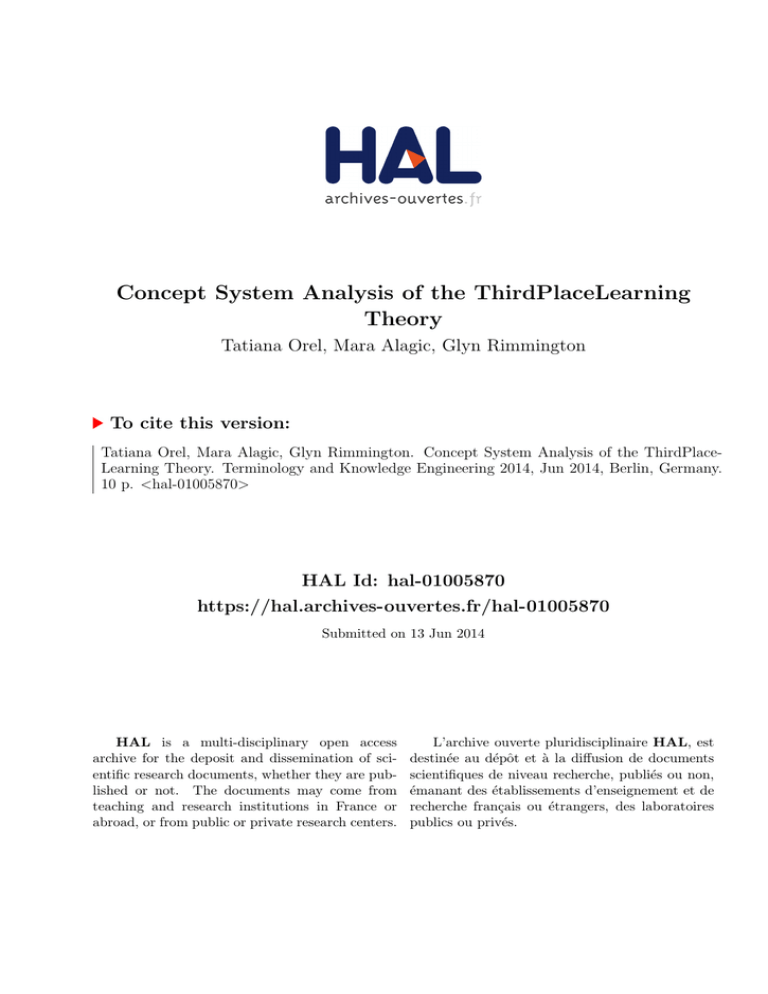
Concept System Analysis of the ThirdPlaceLearning Theory Tatiana Orel, Mara Alagic, Glyn Rimmington To cite this version: Tatiana Orel, Mara Alagic, Glyn Rimmington. Concept System Analysis of the ThirdPlaceLearning Theory. Terminology and Knowledge Engineering 2014, Jun 2014, Berlin, Germany. 10 p. <hal-01005870> HAL Id: hal-01005870 https://hal.archives-ouvertes.fr/hal-01005870 Submitted on 13 Jun 2014 HAL is a multi-disciplinary open access archive for the deposit and dissemination of scientific research documents, whether they are published or not. The documents may come from teaching and research institutions in France or abroad, or from public or private research centers. L’archive ouverte pluridisciplinaire HAL, est destinée au dépôt et à la diffusion de documents scientifiques de niveau recherche, publiés ou non, émanant des établissements d’enseignement et de recherche français ou étrangers, des laboratoires publics ou privés. Concept System Analysis of the ThirdPlaceLearning Theory 2. 3. Orel, T1., Alagic, M2. & Rimmington, G.M3. 1. tatiana.orel@gmail.com, Algonquin College Language Institute, Canada mara.alagic@wichita.edu; College of Education, Wichita State University, USA glyn.rimmington@wichita.edu; College of Liberal Arts & Sciences, Wichita State University, USA Abstract. The ThirdPlaceLearning (TPL) frame and its sub-frames, constructed by Cognitive Linguistics methods, is a visual representation of the interconnected concepts. A list of defined terms and their underlying concepts were developed to create this frame – a representation of connections and associations within this frame. The concepts were then clustered within mental constructs, named categories, and used to clarify the structure of the TPL theory. The TPL frameand its sub-frames represent an associative network of concepts and terms belonging to different categories. It is a visualization of the TPL theorythat comprises a set of dialogically negotiated mental/conceptual constructs. Keywords:Category, cognitive linguistics, conceptsystem, frame, mental representation, proposition, terminology, ThirdPlaceLearning, TPL relational criteria, cognitive-onomasiologicalmodeling 1 Research Overview The ThirdPlaceLearning (TPL) theory [18] of InterCulturalCommunication (ICC) describes the liminal phase between the interlocutors' perspectives. In contrast with othercross-cultural or trans-cultural theories of ICC, TPL views ICC interaction from a ―third‖ vantage point. In other words, TPL uses a vantage point different to either interlocutor. This is achieved through developing an understanding of each other’s perspective and thus a better understanding of each interlocutor’s own perspective, through Perspective Sharing and Perspective Taking(PSPT). This latter process is facilitated by a set of processes and conditions, we call the TPL relational criteria, [1], [2], [3], [18] as depicted in Figure 1. In this paper we describe how Cognitive Linguistics (CL) methods [9], [14], [7] were applied to analyze the TPL concepts and terminology. Epistemological negotiation of ―ways of knowing‖ among the authors was required to connect education, intercultural communication, philosophy, psychology, terminology, linguistics and cognitive science with various theories of knowledge,because of the interdisciplinary character of the TPL theory. To achieve deeper understanding of TPL theory, the authors collaboratively explored a glossary of terms and conceptual models (frames) that represent associations among the TPL concepts. The focus of our terminology research of the TPL theory has moved from the prescriptive and descriptive approaches [22],[19]to the cognitive aspects of terminol- ogy.These aspects include the study of mental mechanisms of an individual interacting with the world that are reflected in his/her language [5],[15],[17],[21]. The application of CL to the terminology researchillustrates the value of modeling mental processes. This cognitive modeling primarily assigns a structure to language units in a corresponding terminology and explains the behavior of terminological units in language. The holistic system of knowledge, or worldview, is specific to an individual’s consciousness and facilitates his/her orientation in a scientific or professional sphere; it comprises cognitive structures and terminology. Construction of conceptual structures (i.e. frames) of a terminology by means of cognitive research of their linguistic units (i.e. terms) gave us a holistic picture of a certain sphere of knowledge. Further, this type of construction enabled us to learn about complex theories of an area of knowledge that is related to TPL.Through an ongoing dialog, we developed a CL perspective of the TPL theory and its terminology that comprised a thesaurus, categories and frames construction. TPL Thesaurus. To investigate the TPL theoretical framework [18] based on the CL methods, we first constructed an English languagethesaurus of TPL terms and definitions. Where we used a word specific to the TPL framework, we defined it in the thesaurus using the ISO 704 standards [11]. TPL theory and its relational criteria were recorded and stored by means of terms based on an awareness and consciousness of terminology construction that involved its cognitive-communicative functioning. The TPL system was characterized with following terminological processes: identification of the terms assigned to each TPL concept and adding new terms when necessary; analysis ofeach TPL concept, concept structureand associated connections; and finally, compilation and management of the resultant terminology. TPL Categories.The TPL concepts and their corresponding terms were clustered into mental constructs named categories based on their properties and functions. According to Kövecses, ―...the conceptual categories… are the backbone of language and thought...‖ [13, p. 17]. Therefore, categories are always constructed with regard to a specific sphere of knowledge, where categories reflect the essential properties and connections within reality, as represented by human thought processes. TPL Frames Construction.The associative network of concepts and terms belonging to different TPL categories was used to construct a series of frames and sub-frames. They are a form of visualization of the TPL theory comprising a set of dialogically negotiated mental/conceptual constructs. 2 Frame Construction of the TPL Knowledge Base Some research in the field of terminology science [8],[15],[17],[21] uses frame analysis to discover the mechanisms of human knowledge representation and to study language as a mental construction. Terminologyresearch, in the context of CL, presupposes the construction of a knowledge sphere conceptual system.The lattercomprises connections between knowledge structures and their language representations. Hence, the frame analysis allows us to assume that language is a mental formation that is generated by human thought; a system of human knowledge representation. Therefore, the cognitive-communicative approach helps us to conceptualize the connections between firstly, phenomena that exist in the symbolicrepresentation of lan- guage and secondly phenomena that are hidden from our observation, deep within the human consciousness. Cognitive linguists use this approach to better understand processes and mechanisms of human cognition. The aim of our research was to construct a frame[16] representation of the TPL terminology system and to understand existing types of relationships between different concepts.The term frame was first used byMinsky in 1975 as a paradigm to understand visual reasoning and natural language processing.According to Fillmore [9], a frame is an abstraction (an ―idealization‖) of an individually construable form of mental representation encompassing one’s experience, knowledge, perception, etc. Barsalou [4]defined frames as complex conceptual structures that are used to, ―…represent all types of categories, including categories for animates, objects, locations, physical events, mental events and so forth…‖ (p. 29). Incorporation of knowledge about a fragment of real life into a frame involves encoding of information about it (e.g., participants, their behavior, etc.). In other words, a frame is a unified knowledge structure or specific schematization of experience that provides a conceptual basis for a significant lexical corpus. ―Frames are continually updated and modified due to ongoing human experience, and are used in reasoning in order to generate new inferences‖ [6, p. 223]. Research of knowledge organization of any sphere of human activity by means of the frame analysis is an effective way of terminology systems’ study where a frame is a structural unit that helps us to visualize integration of concepts into a real communicative situation. Theframe of a knowledge sphere can perform three functions: (i) reflect the structure of a knowledge sphere, (ii) result in knowledge sphere cognition, and (iii) record knowledge in human mind (mental representation). According to Minsky [16], the structural organization of frames is a network of nodes and their relations where nodes contain specific instances of data. A conceptual system (frame) captures an overarching, holistic representation of a knowledge sphere. Different frames and sub-frames of a system share the same terminals where activation of higher or lower levels of slots/nodes is initiated, i.e. one and the same node of a lower level may be included in different frames. As pointed out in some studies[20], sub-frames may contain information of different complexity, from a simple marker of special background knowledge to encyclopedic data. Every sub-frame reflects conceptualized knowledge about a certain entity in the world but is not a simple enumeration of entity’s markers. Some slots are filled with general information and other slots with specific information. Activating an existing frame by means of data at the lower level, we can reconstruct the structure of a situation as a whole. Terminology categorization is reflected in the TPL categories, and it allowed us to understand yet another representation of the way concepts are organized within these categories. The main relations among TPL concepts were identified by means of cognitive-onomasiological modeling. The propositional analysis of this modeling is an information compression process that allows us to demonstrate that reality is structured in a certain way by language. 2.1 Visual Conceptualization of the TPL Theory TPL frame construction described here was based on the visual representation of the TPL theory components, which encompass relational criteriacontexts, learning domains, etc. [1],[2] and[3]. The visual conceptualization of the TPL theory is an initial generalized version of terminology representation and relationships among the main terms used to represent the TPL conceptual network via frames. In Fig.1 the following TPL relational criteria are presented: active listening, holistic mindfulness, dialectic thinking, critical co-refection, intercultural sensitivity and conscientization. Fig.1.Concept map of the TPL theory The visual conceptualization of the TPL theory is an initial generalized version of terminology representation and relationships among the main terms used to represent the TPL conceptual network via frames. In Figure 1 the following TPL relational criteria are presented: active listening, holistic mindfulness, dialectic thinking, critical co-refection, intercultural sensitivity and conscientization [2]. 2.2 TPL Frame For each frame we compiled a list of terms for representation of frames or subframes and organized them according to their categories. To visualize the process of cognitive modeling, we include, below, the results of terminology categorization and propositional analysis for the general TPL frame (see Table 1): Table 1.TPL frame: Categorized terms and related propositions Term Category Proposition Third Place Learning TPL Relational Criterion Abstract Concept [CONCEPT - BE ABOUT – WHOLE/PART] Disorienting Dilemma Abstract Concept [CONCEPT – BE OF – TYPE/KIND] Misconception Miscommunication Preconception Abstract Concept [CONCEPT – BE – WRONG] Iceberg effect Abstract Concept [CONCEPT1 – CHANGE – CONCEPT2] Self-Identity Abstract Concept [CONCEPT – BE ABOUT – SELF] Active Listening Critical [Co]Reflection Process [PROCESS – BE OF – TYPE/KIND] Perspective Sharing/ Taking/Shift Process [PROCESS – DEAL WITH – STATE/ABSTRACT CONCEPT] Intercultural Sensitivity State [STATE (relation) – BE OF – TYPE/KIND] Conscientization State [STATE1 – (NOT) BE AWARE OF – STATE2] Holistic Mindfulness Hybrid [PROCESS/STATE – BE OF – TYPE/KIND] Dialectic Thinking Hybrid [PROCESS/CONCEPT – BE OF –TYPE/KIND] ICC Context Hybrid [TIME/SPACE/RELATION – BE OF – TYPE/KIND] Multiple Perspectives Hybrid [STATE/CONCEPT – BE OF –TYPE/KIND] Point of View Hybrid [STATE/CONCEPT – BE OF – TYPE/KIND] Perspective Hybrid STATE/CONCEPT Liminal Phase Hybrid [TIME/SPACE – BE PART OF – WHOLE] Discourse (of learning) Space [SPACE – BE LIMITED BY – BOUNDARY] Learning Domains: Cognitive; Psychomotor; Interpersonal and Affective Space [SPACE – BE OF – TYPE/KIND] The TPL frame (see Figure 2) is a mental representation of interconnected concepts, which also includes six subframes/slots of each TPL relational criterion. ThirdPlaceLearning (ABSTRACT CONCEPT 1) occurs in a particular environment (SPACE1) which comprises the discourse of learning within the four learning domains (cognitive, psychomotor, interpersonal, affective) (SPACE 3). Discourse of learning is grounded in critical social and cognitive theories and includes certain aspects of TPL, such as environment (formal, informal, class, home, etc.), power relations (employer, employee), culture (Khazakstani, Lithuanian), communication (introverted, extroverted). At the same time, the six TPL criteria occur within four learning domains. For example, critical co-reflection involves the cognitive learning domain, whereas bodymindfulness involves the affective and cognitive domains. Fig.2. TPL frame TPL is ICC context-dependent, where ICC context encompasses spatial, temporal, relational, and historical subcontexts (TIME/SPACE 2/RELATION). A disorienting dilemma, misconception, miscommunication, preconception (ABSTRACT CONCEPT3, 4, 5) together with an iceberg effect (ABSTRACT CONCEPT2) might initiate the transformational process of ThirdPlaceLearning [18]. The iceberg effect based on the iceberg’s deep, (subconscious) levels—meaning structure—is a cultural lens through which we can see other cultures. Our worldview of other cultures is subjectively formed due to the influence of our individual meaning structures. TPL relational criteria (ABSTRACT CONCEPT6) is a combination of: particular cognitive and communicative PROCESSES1, 2, 3 (dialectic thinking, active listening; critical co-reflection); awareness and somatic-emotional STATES1, 2 (intercultural sensitivity, conscientization); and as well as a conceptual hybrid STATE & PROCESS with somatic-emotional process and awarenessstate (holistic mindfulness). When TPL relational criteria are in play, a disorientationmay trigger a transformation of the initial self-identity of an individual (ABSTRACT CONCEPT 7) including an individual’s perspective, point of view, or multiple perspectives (STATE & ABSTRACT CONCEPT1) to a new self-identity (ABSTRACT CONCEPT2) with a new augmented perspective, point of view, or multiple perspectives (STATE & ABSTRACT CONCEPT2). This transformation happens by means of the communicative and cognitive PROCESSES4, 5, 6 (perspective taking, perspective sharing, perspective shift), during or within a liminal phase (TIME & SPACE). As an example of a sub-frame analysis, we would like to focus on conscientization, or critical consciousness, a critical social theory concept developed byFreire[10]. We define conscientization as, first, an awareness of privilege, oppression, deprivation and power difference between individuals and, second, taking action to minimize the power difference so as to improve communication. Further, Freire explains critical consciousness as a sociopolitical educative tool that engages learners in questioning the nature and consequences of their historical and social situation. A simple example is the acceptability of students asking questions or sharing opinions in a school classroom. In some classrooms this is encouraged and in others it is seen as an affront to the teacher. In the latter case, a conscientized student is aware of the freedoms of the former case, and realizes the lack of freedom imposed by the teacher.The conscientized student may want to change this situation. 2.2.1. Conscientization Frame The frame of conscientization, a sub-frame of the TPL frame, constructed by CL methods, is a visual representation of the interconnected TPL concepts. A list of defined terms and their underlying concepts was developed to create this frame—a representation of connections and associations within the conscientization criterion. The concepts were then clustered within mental constructs, named categories, and used to clarify the structure of the conscientization criterion within the TPL theory. The conscientization sub-frame represents an associative network of concepts and terms belonging to different categories. It is a form of visualization of the conscientization criterion comprising a set of dialogically negotiated mental/conceptual constructs. The sub-frame Conscientization is represented by the list of terms (see Table 2), which includes their categories and propositions. Table 2.Conscientization subframe: Categorized terms and related propositions Term Category Proposition Conscientization State [STATE1 – (NOT) BE AWARE OF – STATE2] Power relationship Power difference State [STATE (relation) – BE OF – TYPE/KIND] Oppression State [STATE – BE USED FOR – OPERATION] Privilege Property Conformity Abstract concept [CONCEPT – BE USED FOR – OPERATION] Having a voice Ability [ABILITY – BE IN – COMMUNICATION] Courage Ability To illustrate our results (Fig. 3), we described the associative connections among the terms and CONCEPTS standing behind them.Conscientization (STATE1) is an awareness of oppression (STATE4) and AGENT B taking action to move towards a position that minimizes the effect of power difference (STATE2) on communication with AGENT A who has privilege (PROPERTY). Within the context of apower relationship (STATE2), an oppressed AGENT B needs to develop the ABILITY 1 (having a voice) and ABILITY2 (courage) to lower/overcome power difference. Fig.3.Conscientization sub-frame Having a voice is the ability to participate in a dialog and freely express ideas, opinions and perspectives while being respected and appreciated. Courage is the capability to ask about the other person's perspective or express your opinion, irrespective of the prevailing power relations and social conformity. 3 Conclusions In conclusion, the concepts and methods of CL are applicable to many disciplines, such as terminology, applied linguistics, descriptive linguistics, lexicography, cultural linguistics, cultural studies, language acquisition, discourse studies and ideology, sociolinguistics, visual communication, stylistics, poetics, pedagogical linguistics, computational linguistics, signed language, philosophy, pedagogy, psychology and within interdisciplinary frameworks [12]. In our research, we presented a multidisciplinary study based on the intersection of terminology, education, intercultural communication, cultural studies, psychology and linguistics, where the methods of CL were widely applied. We described and presented the main TPL categories that may be used to assist learners to connect appropriately the abstract concepts of the TPL theory with certain linguistic categories and acquire the terminology belonging to this theory. Also, we used the methods of cognitive-onomasiological modeling to construct the propositional models for all the terms representing the TPL theory. It gave us an opportunity to distill the main mental concepts that underpin the TPL lexicon and bring them together in an associative network in the form of conceptual models or frames described in the previous passages. In other words, the application of these CL methods allowed us to visualize the associative relation of terms as well as mental concepts standing behind them in the form of frames. The frames will assist our students to understand more deeply and precisely the conception of the TPL theory and help them allocate this network of concepts in certain categories. Thus, these CL methods provided an effective explanation and visualization of TPL, which is a complex and abstract scientific conceptthat is described by a relevant terminology system. Moreover, by means of these methods, the TPL concepts at the mental level and the terms representing them at the language level were constructed into an associative network, which is an indicator of a well-developed and mature terminology where all the terms and concepts are interconnected. References 1. Alagic, M., Orel, T. & Rimmington, G. M. (2010, September 14-16). Frames as a model for understanding cultural sensitivity. Proceedings of 7th International Conference on Intercultural Communication Competence, Khabarovsk, Russia, 198-207. 2. Alagic, M. (2009). Third Place Learning: Relational criteria for developing intercultural capital. Academy of Management Annual Meeting - Professional development Workshop: Teaching and Learning in Different Cultures, Chicago. 3. Alagic, M., Rimmington, G. M. & Orel, T. (2009). Third place learning environments: Perspective sharing and perspective taking. International Journal of Advanced Corporate Learning. 4 (2). http://online-journals.org/i-jac/article/view/985 4. Barsalou, L.W. (1992). Frames, concepts, and conceptual fields. In E. Kittay& A. Lehrer (Eds.), Frames, fields, and contrasts: New essays in semantic and lexical organization (pp. 21-74). Hillsdale, NJ: Lawrence Erlbaum Associates. 5. Cabré, T.M. (1998). Terminology: Theory, methods and applications. Amsterdam: John Benjamins Publishing Company. 6. Evans, V. & Green, M. (2006). Cognitive linguistics: An introduction. Edinburgh: Edinburgh University Press. 7. Geeraerts, D. &Cuyckens, H. (Eds.). (2007). The Oxford handbook of cognitive linguistics.Oxford: Oxford University Press. 8. Faber, P., León, P., & Prieto, J.A. (2009). Semantic relations, dynamicity, and terminological knowledge bases. Current Issues in Language Studies, 1. Retrieved from http://www.academicpress.us/journals/511X/download/v1n1-1.pdf 9. Fillmore, Ch. J. (1977). Topics in lexical semantics. In R. Cole (Ed.), Current Issues in Linguistic Theory (pp. 76-138). Bloomington, IN: Indiana University Press. 10. Freire, P. (1968|1970). Pedagogy of the oppressed. (transl. Ramos, M. B.). New York City: Continuum International Publishing. 11. ISO 704. (2000). Terminology work – principles and methods. Retrieved from http://semanticweb.kaist.ac.kr/org/tc37/pdocument/standards/ISO%20704.pdf 12. Kristiansen, G., Achard, M., Dirven, A., & de Mendoza Ibanez, F.J.R. (Eds.). (2006). Cognitive linguistics: Current applications and future perspectives.Berlin: Mouton de Gruyter. 13. Kövecses, Z. (2006). Language, mind, and culture: A practical introduction.Oxford: Oxford University Press. 14. Lakoff, G. (1987). Women, fire, and dangerous things: What categories reveal about the mind. Chicago: University of Chicago Press. 15. Manerko, L. A. (2004). Nominative units in scientific English. Terminology Science and Research. 15, 7-16. 16. Minsky, M. (1977). Frame theory. In P.N. Johnson-Laird & P.C.Wason (Eds.), Thinking: Readings in cognitive science. (pp. 355-376). Cambridge, MA: Cambridge University Press. 17. Orel T. (2007). Terminology analysis by means of frame construction (on the basis of the English telecommunications terminology). XVI European Symposium on Language for Special Purposes (LSP) “Specialized Language in Global Communication”, Hamburg: University of Hamburg, 119-121. 18. Rimmington, G. M. & Alagic, M. (2008). Third Place Learning: Reflective inquiry into intercultural and global cage painting. In book series Huber-Warring, T. Teaching <~> Learning Indigenous, Intercultural Worldviews International Perspectives on Social Justice and Human Rights. Charlotte, NC: Information Age Publishing Inc. 19. Sager, J.C. (1990). A practical course in terminology processing. Amsterdam, Philadelphia: John Benjamins Publishing Company. 20. Stevenson, R.J. (1993). Language, thought and representation. Hoboken, NJ: John Wiley and Sons. 21. Temmerman, R. (2000). Towards new ways of terminology description. Amsterdam: John Benjamins Publishing Company. 22. Wüster, E. (1976). International activity in terminology: 75 years of researchfoundations and challenge for the rest of the century. Infoterm. 3, 32-40.
